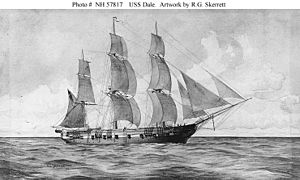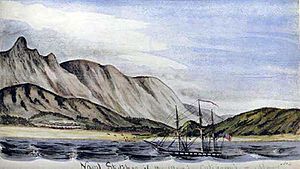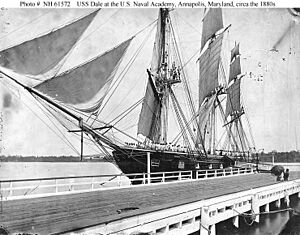USS Dale (1839) facts for kids
 |
|
Quick facts for kids History |
|
|---|---|
| Name | USS Dale |
| Namesake | Richard Dale, Commodore U.S. Navy |
| Builder | Philadelphia Navy Yard |
| Launched | 8 November 1839 |
| Commissioned | 11 December 1839 |
| Decommissioned | May 1859 |
| Recommissioned | 30 June 1861 |
| Decommissioned | 20 July 1865 |
| Recommissioned | 29 May 1867 |
| Renamed | Oriole, 30 November 1904 |
| Fate | Transferred to the U.S. Revenue Cutter Service, 23 July 1906 |
| General characteristics | |
| Type | Sloop-of-war |
| Displacement | 566 long tons (575 t) |
| Length | 117 ft (36 m) |
| Beam | 32 ft (9.8 m) |
| Draft | 15 ft 8 in (4.78 m) |
| Propulsion | Sail |
| Speed | 13 kn (24 km/h; 15 mph) |
| Complement | 150 officers and enlisted |
| Armament | 14 × 32-pounder guns, 2 × 12-pounder guns |
USS Dale (1839) (later Oriole) was a sloop-of-war, a type of warship, in the United States Navy. It was put into service on December 11, 1839. The Dale was a busy ship. It took part in the Mexican–American War and the American Civil War. It also helped stop the slave trade along the coast of Africa. Later, it was used by the United States Revenue Cutter Service and the United States Coast Guard. The Dale was often put "into ordinary," which means it was placed in a naval reserve fleet when not actively needed.
Contents
Building and Starting Service
The Dale was one of six warships that the U.S. Congress approved in 1837. It was built at the Philadelphia Naval Shipyard. The Dale was known for being the fastest of its group of five similar ships.
The ship was launched, meaning it was put into the water for the first time, on November 8, 1839. It officially started service on December 11, 1839, with Commander John Gwinn in charge. The ship was named after Richard Dale, a brave officer who fought in the American Revolutionary War. He was also a leader in the early United States Navy.
First Journeys Across the Ocean
The Dale's first long journey began on December 13, 1840. It sailed all the way around Cape Horn at the tip of South America to join the Pacific Squadron. Its main job was to protect American trading ships and whaling boats in the Pacific Ocean.
In 1842, the Dale was part of a fleet that mistakenly thought war had started with Mexico. The fleet briefly captured a town in California, but quickly realized their mistake and left. After this, the Dale returned to the east coast in October 1843. It was then put into reserve until 1846. In June 1846, the Dale began its second journey to the Pacific, continuing to patrol the coast of South America.
Fighting in the Mexican–American War
When the Mexican–American War began, the Dale was sent north. It arrived off the coast of Monterey, California, in January 1847. For the rest of the war, it patrolled the coasts of Mexico and California. The Dale captured several Mexican ships. Its landing parties, which were groups of sailors sent ashore, also raised the U.S. flag over towns like Guaymas and Mulegé.
In September 1847, the Dale arrived in San José del Cabo. It was tasked with stopping movement between Guaymas and Mulegé. On September 30, the Dale tried to get local leaders in Mulegé to support the United States. When they refused, sailors and marines from the Dale landed. They faced strong resistance from Mexican forces. The American forces eventually returned to their ship.
Later, on November 8, 1847, the Dale helped capture the town of Guaymas. Commander Selfridge, the ship's leader, was injured during this action. After the war ended in February 1848, the Dale continued to patrol until the summer of 1849. It then sailed back to New York and was put into reserve again.
Stopping the Slave Trade
The Dale made three long trips along the African coast. Its mission was to help stop the illegal slave trade as part of the Africa Squadron. In August 1850, it was put back into service. It sailed to the Cape Verde Islands to replace another ship, the USS Yorktown, which had sunk. The Dale rescued the survivors of the Yorktown and took them to safety.
During its time in Africa, the Dale sailed a huge distance, over 28,000 miles. It was also involved in a brief attack on the small Kingdom of Johanna in 1851. In November 1857, the Dale reportedly captured a slave ship called the W.G. Lewis off the coast of Kongo. The Dale was taken out of service in May 1859.
Service During the American Civil War
The Dale was put back into service on June 30, 1861, at Portsmouth Naval Shipyard in Maine. It joined the Union blockade during the American Civil War. Its job was to stop supplies from reaching the Southern states. On its way to Port Royal, South Carolina, it captured two smaller ships.
The Dale then served as a supply and guard ship in Port Royal until September 1862. After getting repairs, it went to Key West in December. There, it served as a ship for storing weapons and supplies until July 3, 1865.
The Dale was taken out of service again on July 20, 1865. It stayed in reserve until May 29, 1867, when it was put back into service. It became a training ship at the United States Naval Academy in Annapolis, Maryland. It served there until 1884. After leaving Annapolis, the Dale was used as a "receiving ship" at the Washington Navy Yard until 1894. A receiving ship was like a floating barracks where new sailors waited for their assignments.
In 1895, the Dale was given to the Maryland Naval Militia. On November 30, 1904, its name was changed to Oriole. The Navy officially removed it from its list of ships in February 1906. In July 1906, it was transferred to the United States Revenue Cutter Service in Baltimore, Maryland.
As the Oriole, it served as a dormitory ship for cadets at the School of Instruction in Arundel Cove, Maryland. The old ship had leaks and needed constant pumping to stay afloat. Finally, on September 17, 1921, after almost 82 years, the Oriole was returned to the U.S. Navy. It was then sold as an old, worn-out ship.
Images for kids








